Scohaboy bog, located in north Tipperary, is a rare and wonderful place.
Particularly so when, on a recent bright February morning, I joined a group of 40 Agricultural Science & Sustainability degree students and staff from nearby Gurteen College on an educational walk in the company of Jim Ryan.
Jim, a self-described ‘greenie’, has dedicated his life’s work to saving and restoring Irish bogs – previously through NPWS, but now as a volunteer with the Community Wetlands Forum.
Jim speaks enthusiastically about the importance of bogs and how our perception of them has evolved over time.
As well as a repository for bodies, butter and biodiversity, bogs helped keep generations of Irish people warm, to the extent that turf has become embedded in our cultural heritage and national psyche.
Today, bogs are extolled as huge carbon stores – an Irish rainforest – this critical function taking centre stage due to the climate crisis. This new perspective has led to well-documented tensions between turf cutters and the authorities obliged to protect the bogs.
Collaboration
What’s possibly most rare and wonderful about Scohaboy is the ongoing collaboration between state agencies (in particular, NPWS and Coillte), scientists and the local community, including 50 private landowners, farmers and turfcutters.
Together, they have restored 250ha of bog (10% of the original area), converting what was once a leaking carbon ‘source’ into an expanding carbon ‘sink’.
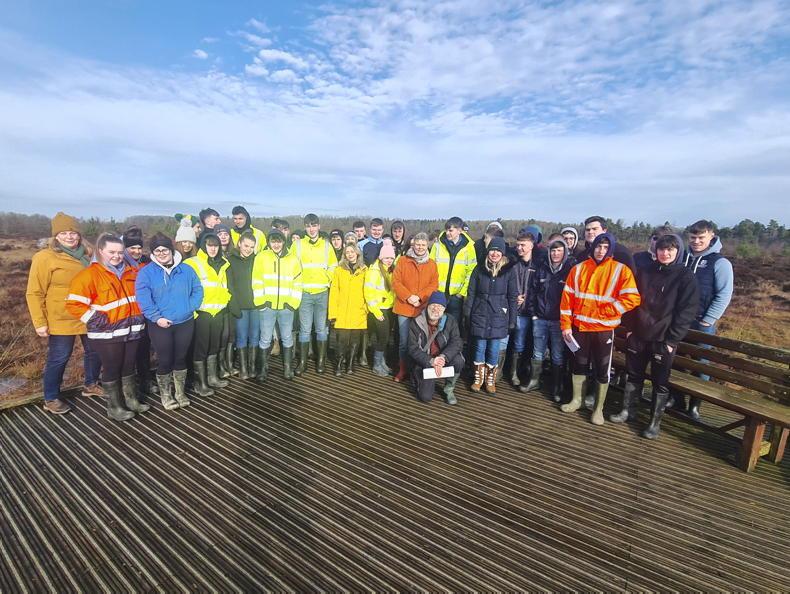
Jim Ryan (kneeling) with Agricultural Science & Sustainability degree students.
Gearóid Ó Foighil of Cloughjordan Community Development Association has spent the past decade tirelessly consulting, engaging and building relationships between stakeholders.
He is justly proud of the community group’s key contribution to Scohaboy’s ongoing restoration, acting as “the glue that binds it all together”, helping to ensure that the process is achieved without conflict.
It’s fitting, therefore, that the local community now gets to enjoy the fruits of their labours – extensive boardwalks and viewing platforms enabling safe, dry access to witness their wetland wonder.
Restoration concerns
The students pay close attention to Jim’s fascinating overview. They learn that milk has more solids in it than the bog, so “it’s as close as they’ll get to walking on water”.
They get to see Sphagnum moss – the ultimate “bog builder” – which can soak 20 times its own weight in water (or blood, hence the use of this natural antiseptic for dressing wounds during World War I).
They hear about contractors fitting natural peat “bunds” to block drains and “contour bunds” to speed up rewetting. Jim describes how keeping boundary drains open protects neighbouring holdings and helps ease farmers’ understandable fears over rewetting.
Today, bogs are extolled as huge carbon stores – an Irish rainforest – this critical function taking centre stage due to the climate crisis
Crowded onto the viewing platform like an Ark on the boggy expanse, the students, while attentive, are reticent when drawn out about contentious environmental issues like ‘rewetting’ and ‘restoration’, though a decisive show of hands makes clear their general concern.
Speaking with some students individually elicits a more nuanced – and impressively considered – response.
Charlene Powell from Nenagh, who does relief milking and helps at home with an organic veg business, says that “you need to listen to the young people more, we’re the ones who have to do the work and live with the consequences of climate change”.
Conor Ryan, from a Roscommon tillage farm, says his peers are up for the challenge: “Give us the plans and we’ll carry them out, but at the end of the day, farming is a business, it has to pay, and farmers have families to rear just like everyone else.”
A just transition
Clearly, Charlene and Conor aren’t intimidated by the prospect of change – they “get” the need and the logic, but are understandably insistent that farmers’ needs be also acknowledged and addressed.
They also stress that farmers generally have a strong work ethic and much prefer opportunities to earn and innovate, rather than relying on “handouts”.
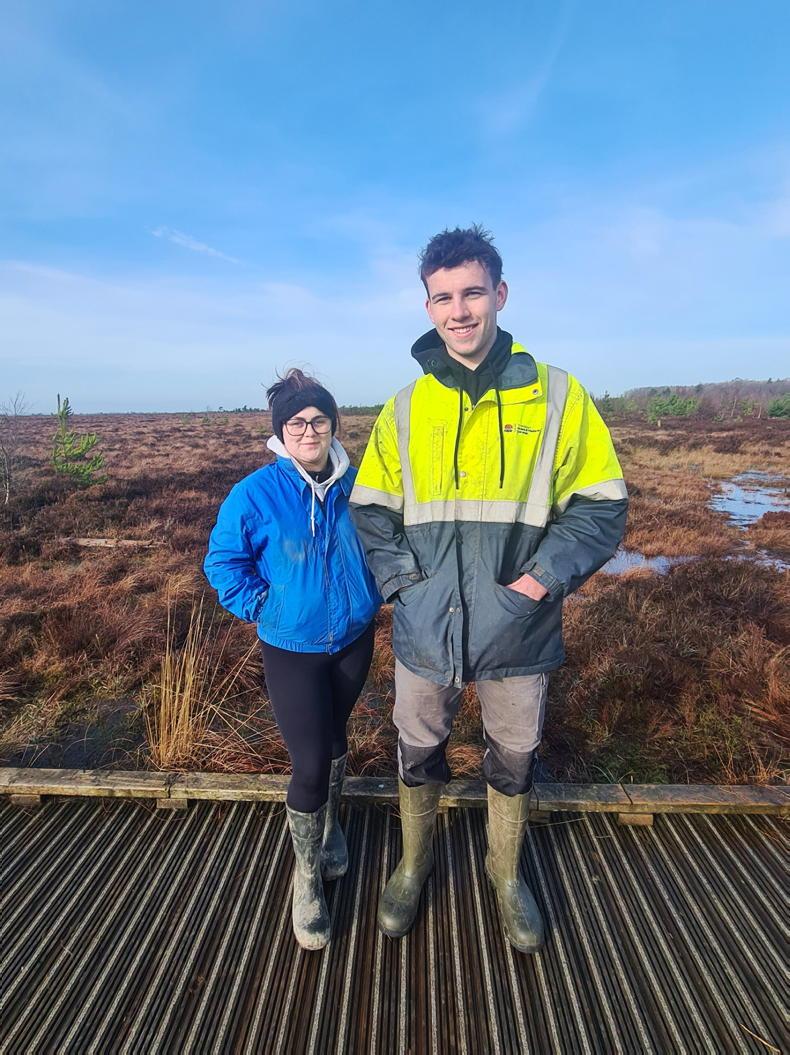
Students Charlene Powell and Conor Ryan are upbeat but realistic about their farming futures.
This point resonates with Jim’s perspective – he sees farmers’ labour and expertise being essential to maximise biodiversity in the transition areas between the wet bog and surrounding dry land.
Where the money comes from for this “just transition”, and how reliable it is in the long term, are legitimate questions – particularly for the impending Nature Restoration Law – as farmers rightly need certainty before making such profound changes.
It’s heartening to stand on the often ‘contested ground’ of a bog and to witness the intergenerational exchange of ideas and perspectives, and the potential common ground between the ‘greenie’, the community and the farmer.
It’s also great to see Gurteen College exposing these future farmers to unlikely new ways of looking at the land, and understanding their potential role in providing the ecosystem services which, after all, may be part of their economic future.
This ‘day on the bog’ is about restoration – not only of this special place, but of hope in the future stewardship of the wider Irish landscape, and the vital role that farmers and rural communities can collectively play.
Jim’s top tip for farmers with peat soils is to reduce the intensity of drainage as much as is practicable for their farm.
“Drained peat soils are wasting assets, literally rotting away, and the deeper the drainage, the faster they disappear,” he says.
Financial support is becoming increasingly available for this, according to Jim.
‘Paludiculture’ (a term to describe ‘wetland farming’) is an area of increasing relevance and research. Two recent midland-based EIP projects (www.farmcarbon.ie and www.farmpeat.ie) have been investigating this, among other things.
Farmpeat hosts monthly community gatherings at their eight project sites (next event: ‘Farmers of Clara Bog’ on Friday 1 March 2024).
Scohaboy bog, located in north Tipperary, is a rare and wonderful place.
Particularly so when, on a recent bright February morning, I joined a group of 40 Agricultural Science & Sustainability degree students and staff from nearby Gurteen College on an educational walk in the company of Jim Ryan.
Jim, a self-described ‘greenie’, has dedicated his life’s work to saving and restoring Irish bogs – previously through NPWS, but now as a volunteer with the Community Wetlands Forum.
Jim speaks enthusiastically about the importance of bogs and how our perception of them has evolved over time.
As well as a repository for bodies, butter and biodiversity, bogs helped keep generations of Irish people warm, to the extent that turf has become embedded in our cultural heritage and national psyche.
Today, bogs are extolled as huge carbon stores – an Irish rainforest – this critical function taking centre stage due to the climate crisis. This new perspective has led to well-documented tensions between turf cutters and the authorities obliged to protect the bogs.
Collaboration
What’s possibly most rare and wonderful about Scohaboy is the ongoing collaboration between state agencies (in particular, NPWS and Coillte), scientists and the local community, including 50 private landowners, farmers and turfcutters.
Together, they have restored 250ha of bog (10% of the original area), converting what was once a leaking carbon ‘source’ into an expanding carbon ‘sink’.

Jim Ryan (kneeling) with Agricultural Science & Sustainability degree students.
Gearóid Ó Foighil of Cloughjordan Community Development Association has spent the past decade tirelessly consulting, engaging and building relationships between stakeholders.
He is justly proud of the community group’s key contribution to Scohaboy’s ongoing restoration, acting as “the glue that binds it all together”, helping to ensure that the process is achieved without conflict.
It’s fitting, therefore, that the local community now gets to enjoy the fruits of their labours – extensive boardwalks and viewing platforms enabling safe, dry access to witness their wetland wonder.
Restoration concerns
The students pay close attention to Jim’s fascinating overview. They learn that milk has more solids in it than the bog, so “it’s as close as they’ll get to walking on water”.
They get to see Sphagnum moss – the ultimate “bog builder” – which can soak 20 times its own weight in water (or blood, hence the use of this natural antiseptic for dressing wounds during World War I).
They hear about contractors fitting natural peat “bunds” to block drains and “contour bunds” to speed up rewetting. Jim describes how keeping boundary drains open protects neighbouring holdings and helps ease farmers’ understandable fears over rewetting.
Today, bogs are extolled as huge carbon stores – an Irish rainforest – this critical function taking centre stage due to the climate crisis
Crowded onto the viewing platform like an Ark on the boggy expanse, the students, while attentive, are reticent when drawn out about contentious environmental issues like ‘rewetting’ and ‘restoration’, though a decisive show of hands makes clear their general concern.
Speaking with some students individually elicits a more nuanced – and impressively considered – response.
Charlene Powell from Nenagh, who does relief milking and helps at home with an organic veg business, says that “you need to listen to the young people more, we’re the ones who have to do the work and live with the consequences of climate change”.
Conor Ryan, from a Roscommon tillage farm, says his peers are up for the challenge: “Give us the plans and we’ll carry them out, but at the end of the day, farming is a business, it has to pay, and farmers have families to rear just like everyone else.”
A just transition
Clearly, Charlene and Conor aren’t intimidated by the prospect of change – they “get” the need and the logic, but are understandably insistent that farmers’ needs be also acknowledged and addressed.
They also stress that farmers generally have a strong work ethic and much prefer opportunities to earn and innovate, rather than relying on “handouts”.

Students Charlene Powell and Conor Ryan are upbeat but realistic about their farming futures.
This point resonates with Jim’s perspective – he sees farmers’ labour and expertise being essential to maximise biodiversity in the transition areas between the wet bog and surrounding dry land.
Where the money comes from for this “just transition”, and how reliable it is in the long term, are legitimate questions – particularly for the impending Nature Restoration Law – as farmers rightly need certainty before making such profound changes.
It’s heartening to stand on the often ‘contested ground’ of a bog and to witness the intergenerational exchange of ideas and perspectives, and the potential common ground between the ‘greenie’, the community and the farmer.
It’s also great to see Gurteen College exposing these future farmers to unlikely new ways of looking at the land, and understanding their potential role in providing the ecosystem services which, after all, may be part of their economic future.
This ‘day on the bog’ is about restoration – not only of this special place, but of hope in the future stewardship of the wider Irish landscape, and the vital role that farmers and rural communities can collectively play.
Jim’s top tip for farmers with peat soils is to reduce the intensity of drainage as much as is practicable for their farm.
“Drained peat soils are wasting assets, literally rotting away, and the deeper the drainage, the faster they disappear,” he says.
Financial support is becoming increasingly available for this, according to Jim.
‘Paludiculture’ (a term to describe ‘wetland farming’) is an area of increasing relevance and research. Two recent midland-based EIP projects (www.farmcarbon.ie and www.farmpeat.ie) have been investigating this, among other things.
Farmpeat hosts monthly community gatherings at their eight project sites (next event: ‘Farmers of Clara Bog’ on Friday 1 March 2024).







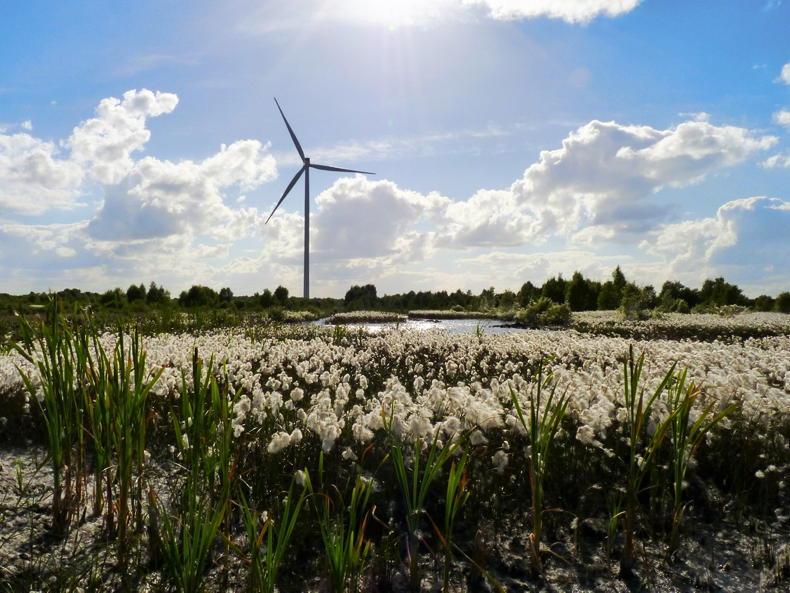
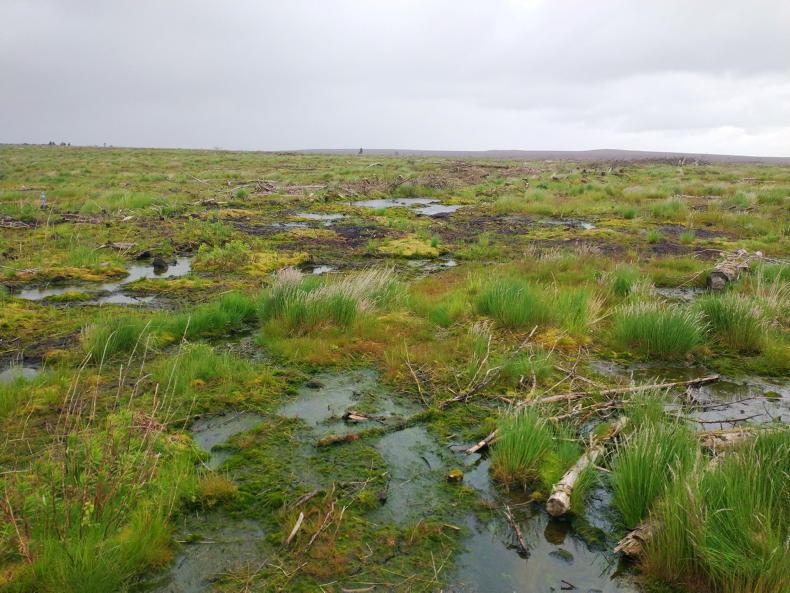

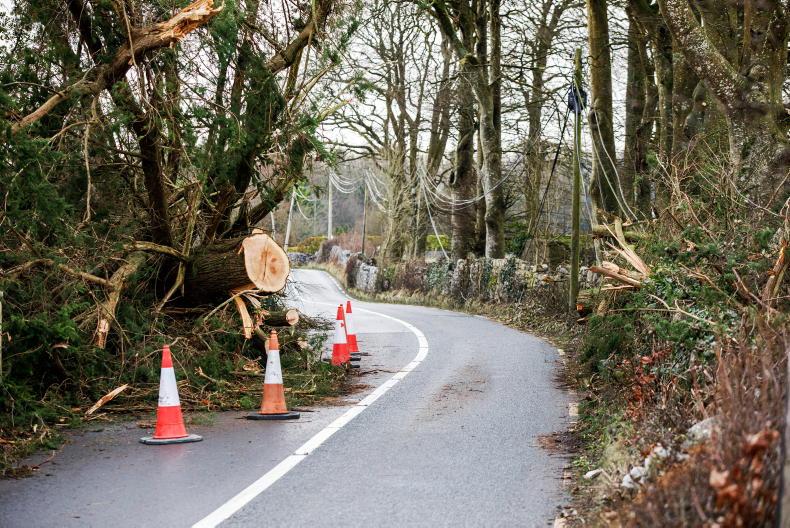
SHARING OPTIONS